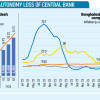Inflation’s obduracy reflects the inadequacies of the policy response

The spike in inflation from 9.41 percent in December to 9.86 percent in January was driven entirely by the rise in non-food inflation.
Food inflation was stable at an elevated 9.6 percent level. Remarkably, non-food inflation increased in both rural and urban markets across all non-food categories.
Food inflation declined from 9.66 percent in December to 9.41 percent in rural markets while increasing from 9.46 percent in December to 9.98 percent in January in urban markets. Pervasive inflation is deeply entrenched.
There are three, not necessarily mutually exclusive, explanations:
First, monetary tightening has not been long enough and tight enough. Maximum lending rates have been allowed to increase by less than 350 basis points since last July. Countries where monetary tightening seems to be working have done much larger tightening for longer. It is, therefore, premature to judge the effectiveness of recent monetary tightening.
Second, foreign exchange shortage, exacerbated by policy uncertainty on Bangladesh Bank's stance on future exchange rates, has not eased. There may have been some second order improvements such as a decline in the rate of decline of forex holdings in the banking system. Consequent increase in parallel market rates have increased the cost of producing and importing goods and services.
Third, one remarkable fact about recent inflation is its volatility driven by greater volatility in food inflation. Prices of some essential food items such as onions, sugar and edible oil tend to be more volatile than others.
Export restrictions in various forms in supplying countries, India in particular, often trigger such volatility. Market manipulation, popularly believed to be through "syndicates", may be operative at least some of the time. The same goes for opportunistic price gouging in response to export restrictions in supplying countries.
Reduction in global inflation have had no impact on inflation in Bangladesh, notwithstanding fading of energy price shocks and their associated pass-through to inflation. The message from the data is loud and clear. Inflation reduction in Bangladesh can't count on global forces.
Inflation has been falling faster than expected in most regions of the globe with the unwinding of supply-side bottlenecks and restrictive monetary policy. Bangladesh has remained immune to these declines.
The Red Sea conflict is unlikely to have been a major factor so far. It could disrupt the global oil supply and cause prices to surge. However, oil prices have not moved much and soaring transportation costs are yet to change the game for global inflation.
Those thinking the Red Sea conflict contributed to the January spike in inflation in Bangladesh should note that the inflation rate in India was stable at 5.69 percent in December 2023 and January 2024, showing little impact of the conflict. What is so special about Bangladesh in this respect?
Course corrections in exchange rate management, greater interest rate flexibility, and complete abstinence from any kind of monetisation of government bonds and private sector bailouts are overdue. Market policing or setting price ceilings don't work. Ensuring market competition, contestability and transparency do. Capricious and ill-prepared legal actions against alleged manipulators will not deliver results and could, in fact, boomerang.
The Bangladesh Bank must remain nimble and steadfast in its tight stance despite growing pressures from the business community to pause rate hikes. Higher financing costs challenge firms refinancing their debt and make credit availability tighter, thus weakening business and residential investment and compounding pre-existing structural challenges. But with inflation so stubborn, borrowing costs can't ease. We can't have our cake and eat it too.
Unrealistic optimism on the part of policymakers does not help either. So much for the overconfident forecasts about inflation falling to 8 percent by December 2023! When policymakers overestimate the likely effects of what they have already done, they fail to take the additional measures needed to get to where they want to be.
The author is an economist

 For all latest news, follow The Daily Star's Google News channel.
For all latest news, follow The Daily Star's Google News channel. 








Comments